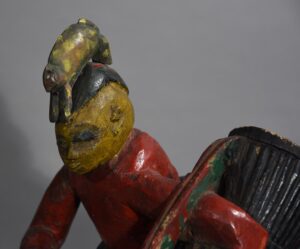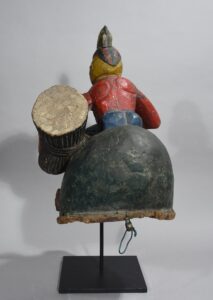OAK 0920-2
Gelede Mask, Yoruba, Nigeria
This remarkably colorful and sculptural Gelede wooden headdress which originates from the Yoruba people is carved of a single piece of wood. It is carved with classical Yoruba facial features: heavy eyelids, bulgy almond-shaped eyes, a flared nose and compressed full lips. The pupils and nostrils are roughly pierced with circular holes. Scarification lines (pele) are incised on the forehead and both cheeks. On the head is placed a seemingly younger male person with a drum and the mask has been used in connection with the annual festival which is held every year between March and May representing the beginning of a new agricultural season. It takes place at the market because the market in the Yoruba tribe was considered a place where the mortals and spirits gather, most importantly where women sell or trade their food. The marketplace represents a woman’s power and presence, the market place was more like their second home, even more important to them than their husbands’.
“Gelede” translated into English simply means: “Headdress”. The Gelede mask is used, among other things, in connection with festival performances to calm witches, also known as “Mothers”, and also honor the creative and dangerous forces of older women, women ancestors and goddesses, all affectionately called “Our Mothers” in the words of writers (Drewal, Henry, John Pemberton III and Rowland Abiodun) the strength of the “mothers”, which strengthens social existence, but it may also be known for its destructive form of witchcraft that destroys life by creating impotence, barrenness and disease and famine for the land, but it does not usually use this force against the Yoruba people, but instead encourages rain and fertile land.
The Ketu-Yoruba people are credited with the invention of Gelede rituals sometime in the latter part of the eighteenth century according to oral traditions throughout the region. A popular Yoruba word says, oju to ba ri Gelede ti de opin iran (“The eyes that have seen Gelede have seen the ultimate spectacle!”). Gelede’s affective power and effect comes from its multimedia format, where art combines song, dance, costume and music to create moving artistic experiences.
This mask was made for the celebration and – not made for sale!
Age: Early 20th century (before 1950).
Measure: H: 37, W: 24, D: 36 cm
Condition: Despite the age and clear use, this beautiful mask with its traditional clear colors is in good condition. Moisture and termites have dug a hole in the right ‘lower jaw’ of the face.
Provenance: Danish private collection. According to the heirs, this mask was collected before 1950.
Literature:
Drewal, Henry; “Yoruba: Nine Centuries Of African Art And Thought” (with John Pemberton III and Rowland Abiodun). New York : Alfred Knopf and The Center for African Art. 256 pp. 1989.
Bacquart, J. B., The Tribal Arts of Africa, Thames & Hudson, 1998.
Drewal, H. J., ‘Efe: Voiced Power and Pageantry‘, African Arts, Winter, vol. 7, 1974.
Drewal, H. J. & Drewal, M. T., Gelede: Art and Female Power among the Yoruba, Indiana University Press, 1983.
Fagg, W. & Pemberton, J. III., Yoruba: Sculpture of West Africa, Collins, 1982.
Lawal, B., The Gelede Spectacle: Art, Gender, and Social Harmony in an African Culture, University of Washington Press, 1996.
Roberts, A. F., Animals In African Art: From the Familiar to the Marvelous, Prestel, 1995.
Request price for Gelede Yoruba






